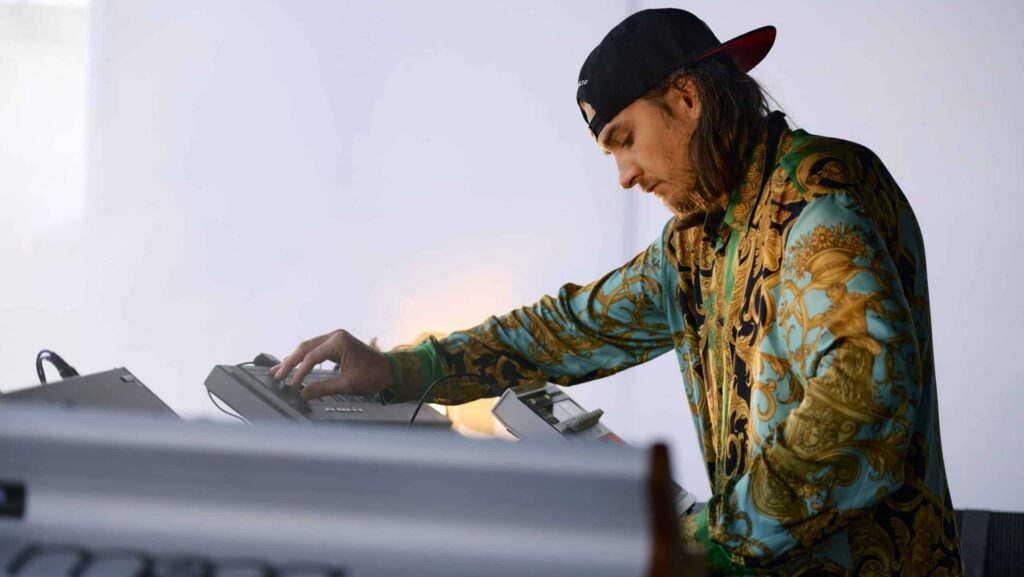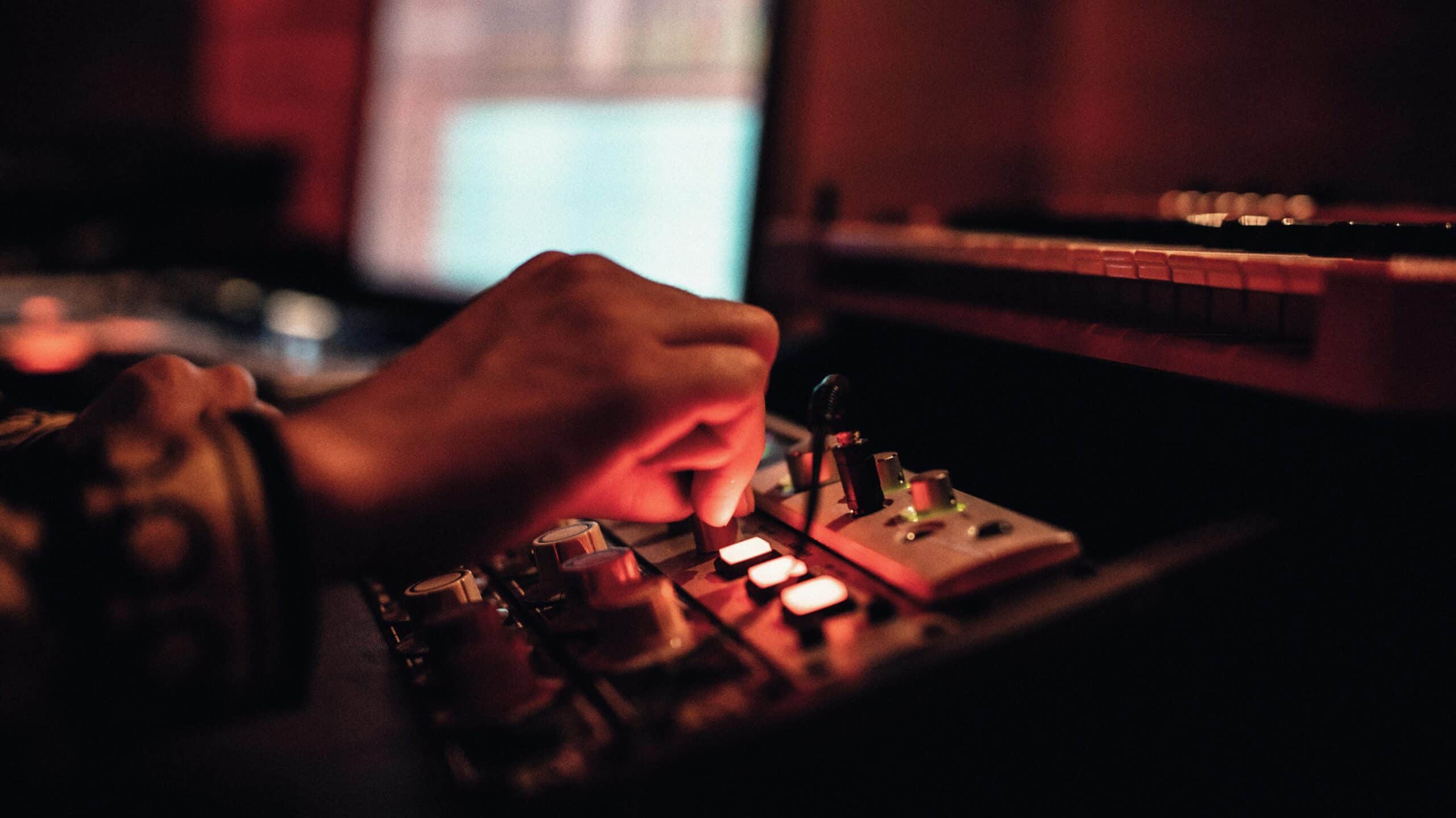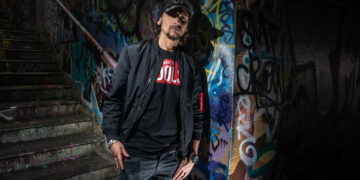Rave daddy Reinier Zonneveld offers advice for bedroom DJs, discusses AI’s role in electronic music, and has a blunt message for techno elitists.
Veteran ravers have watched a lot of artists come and go over the years. Most fall off, and some sell out — but a handful have stayed consistent in their core identities.
An example of the latter? Reinier Zonneveld. From the start of his career, the Filth on Acid label head’s contributions to the rave community have remained consistent because he’s never tried to be anything other than what he was meant to be: a raver.
Reinier stopped by to get whole-heartedly candid about his own journey in the scene, the current state of dancefloors, and how he plans to preserve the ethos of the dance music as the scene moves into uncharted cultural and technological territory. Read on and see what he had to say.
Peep Reinier’s latest collab with hardcore producer Angerfist, and keep an eye out for new releases on Filth on Acid.
Filth on Acid launched in 2017, just before the COVID-era reign of hard dance/hard techno began. How did you know this was the perfect time to start your label? Did you anticipate BPMs rising?
Back then, my main reason for starting the label was because I have always played live sets since I began playing techno. And I did some club shows and there were opening shows at festivals, but it was mostly in the underground scene.
I noticed there was a whole movement around these live shows because I like pretty different music — music that didn’t fit. I released some tracks on Tronic, Minus, and Drumcode — really big labels — but some didn’t fit their sound, so none of them wanted them. But I knew from my shows that these tracks were actually the tracks that I liked to play, and most people really liked them.
I started the label to have an outlet for tracks I couldn’t release anywhere else, and that has always been the idea. I feel blessed to just release music that I really like, and the style doesn’t really matter.
Back then, I was also into hardstyle. This started as a live improvisation in 2016; it was like 144-point-something BPM. Back then, everybody played at 125, maximum 128, maybe 130. There were really hard parties, but nobody was playing 145 or 150.
During my all-night shows, I went from 110 or 115 at the beginning of the evening — atmospheric ambient stuff — to eight hours later, piling on 150 BPM. So I think our label was also kind of moving towards this faster, hard-hitting sound and basically jumpstarted this hard dance, hard techno sound, so to say.
The label has attracted some lethal techno talent over the years — Alex Stein, Matt Sassari, and VE/RA, to name a few. In what way, if any, has Filth on Acid influenced your own sonic evolution or perspective? Are there any artists you’ve signed that’ve scratched a sonic itch you didn’t know you had?
Yeah, we had a crazy run. I remember the first release, Cocktails Mix I. It was the first release in February 2017. We had Oliver Koletzki from Stil vor Talent, which was very big back then. Secret Cinema, Dutch techno legend Matt Sassari — a really special artist as well — and Gabriel Nanda were on the first release. These were all collabs, and they were all very different. From there, it just sort of happened.
A lot of people I met through music tried to release a track with us. I think the biggest moment in the history of the label was “Inferno” with Carl Cox. We collaborated in Australia. He has a brilliant studio there next to his garage, where they work on his race cars because he also has a professional racing team. We were working on this track with Christopher Coe, and we were super excited about it.
Carl said, “Hey, you started this label, right? Let’s release the track there.” And I was like, whoa, is this really happening? I could not believe it. And then we released the track, and it became a huge success. It got featured in a Netflix series, Hollywood movies, and even in commercials worldwide. It’s a track that — even though it’s very pure to the essence of techno, I would say — it still sort of crossed over in a lot of things. I’m super happy that we released this track.
From there, it really exploded, and we got all these super great names. We had Klangkluester, for example, who used to be a tech house DJ and who did his first hard techno records with us in 2017 and 2018. He switched to techno and is now a huge techno superstar — so I’m really happy to have him. And then we had the German ultra-legend Scooter, the Brazilian superstar Alok, the psytrance legends Vini Vici, and the techno legend Umek.
I’ve also been collaborating a lot with Angerfist. We play hardcore shows together and do a lot of tracks together, a lot of which are unreleased. We also played Tomorrowland and made all kinds of edits and new things for that set. It’s really inspiring and really fun to do. And I think, in general, all the collaborations on Filth were super inspiring for me.
We have a really good one coming up with Maddix. It’s one of my favorite tracks I did this year; it will come out on November 21. It’s a really, really driving techno track —like 155 BPM. It’s a very clear production, really energetic, with a great vocal from Sarah De Warren and a nice trance riff in the middle — too much to mention!

Your recent collaboration “Someone to Hold” with Belgian-electronic duo The Subs marked the 200th release for Filth on Acid. How did the collaboration come about? How does it feel to reach such a milestone?
Yes, “Someone to Hold” is a special track because it was released as number 200. I think we met at Rave Rebels at Kompass Klub in Belgium. He just came to talk, and they showed me the vocal they had, then started working on the track. It was a pretty long process. We just kept on adding things and taking things out, and I think it’s a very special track in that sense.
Now, we’re starting to turn the output up a bit again. We have a very, very nice plan for the next year, so to speak, more of an idea of where we want to go as a label.
To have 200 releases on Filth on Acid is a mega milestone. It’s something you dream of when you start a label, especially one with this much success. But I think the best era of Filth on Acid still has yet to come, and in the next few months, we’re going to really push the boundaries and bring something unique and very, very danceable to the table. So I hope you really enjoy it.
Filth on Acid works with artists ranging from underground folk heroes to globally renowned names like Nicole Moudaber. From your perspective, what’s something the newer artists could learn from the pros, and vice versa?
I think you can always learn from everybody. There’s this thing as an artist, or in anything you do in life, that on one hand you don’t want to listen too much to what other people say. You should also listen to your inner drive and do what you think is good. Try to express yourself in an authentic way, and it will lead to the most unique result.
But you can definitely also learn a lot from what others do. I think that I especially see that in production. There are so many people who put so much time into producing, which is great and leads to great music, but I think there should be a balance between knowing the dancefloor, playing a lot of shows, and also playing a lot of shit shows.
If you look at someone like Nicole Moudaber, she earned her stripes through years and years of playing clubs all around the world, from very small to very big stages. This is what makes a great DJ and performer. I think nowadays, with the whole world speeding up because of the internet and social media, it is really cool that younger kids can become famous overnight — though obviously not always.
You can go from playing small 50-person shows or illegal raving, and then boom, you have a hit and you get booked at the big stages. At that moment, you skip a lot. A big part of being a performer is knowing your audience and making mistakes. You need to learn and grow step by step, find your sound, and feel the energy from the people you play for.
There are people who might get disappointed by shows from those artists they see because they’re not ready for this big audience yet. On the other hand, if you throw them in the deep end, some people also perform great. But I think there’s a good thing about slowly building something, and it also applies to performing.
On the other hand, I really like the younger generation, and I love this, also as a label, that there’s so much less of this purist attitude of dissing other music because it’s not good enough and saying “this is too simple” or “this is too cheesy.” In the end, the younger generation is kicking ass by crossing genre boundaries, making what they like, and blowing people’s minds with it.
This makes for a very fun playground for me in the music scene because there’s way more variety —maybe a broader selection —while maybe 15 years ago, in techno, you could take 20 records blindly and mix them together because they almost sounded the same back then. Of course, it was very great music at the time, but there were also a lot of tracks trying to conform to the rules of a certain style. Now, of course, it still happens, but way less, and I think this is a very good thing.

On the same topic, “novice-meets-pro” seems to be the overall theme of dance music right now, most evidently in techno music. The fresher crowd wants to go fast, while the veterans turn their noses up higher than ever before. Where do you stand on the techno scene today? What are your thoughts?
I think it’s this way at all times, right? Older generations always think that all the kids make shit music. The older you get, the shittier it gets. On the other hand, I think people should just do what they do, and listen to what they like. I think there is space for everybody.
I think for promoters and for events, you have to sort of redefine and reshuffle how you fill up stages, and maybe don’t think in terms of opening and closing in the sense of the biggest artists closing. Something we do at my events is to put a really great DJ early in the day that plays 130 BPM proper techno, and after that, you go faster. Maybe not bigger names at the end — actually, the opposite.
For the party as a whole, you sometimes have to rethink how you do it. It’s not as simple anymore. Back in the day, you had a stage, and it was very clear who was going to start and who was going to end. Now, with the variety of music and tempos, you maybe have to redefine how you build up a party.
I think there’s a big responsibility on the people shaping the events, but I already see this going way better. When everybody gets used to it, we will probably go back to a scene where there’s space for everything without annoying each other with too high or low of BPMs. I would just say close your eyes, shut up, and dance. I think it’s better.
Techno music has always been about art meeting technology. You recently posted a clip of yourself going b2b with an AI bot, R2, that was trained with only your music. As a champion of AI, how do you think can techno integrate the technology to enhance creative capabilities?
AI is obviously a big thing. In 2019, I started working with a good friend I knew from my time in econometrics at the university more than 15 years ago. At an afterparty, he explained that he was working with machine learning before the whole AI hype. I was wondering what that was and how it could work with music, so we just started trying things out, for fun, exploring what you can do with it. In the end, we developed an AI model.
Fast forward five years to 2024. It was the first iteration of “R squared” or R2, however you want to say it. This is basically all the music that I ever produced, over 80 days of original music — and obviously, most of it is crap. Somehow, we managed to make a model that can still learn from this, and actually, just by training that, we got a model that can make something random. That’s one version of the model, then there is one where you can do prompt-based music generation.
It has a continuation mode, and this is the coolest one to use. This is the one we use during my shows at the moment because it tends to yield the most usable results. At the show, we have my setup next to it. It’s the same setup, but with robots that can control it from the AI system. Then you have the supercomputer in the back with all these graphics and video cards, these AI cards, and cables from the mixer to this computer.
From another laptop on stage, I have this little dashboard with all the buttons that make the AI do something. It takes a piece of audio and continues what I was doing from there. You never know what’s going to happen, so it’s like a back-to-back partner, but it also sounds kind of like me. Of course, it’s a bit grainy, and the quality isn’t as good as a well-produced track, but because it sits on top of what I’m playing, the combination actually produces crazy, creative results. Sometimes it does something you don’t expect, and you’re forced to work around it and make something of it, which is challenging.
Also, one of the models is really good at layering percussion and beats, so when I’m improvising on my drum computers, I use this model. It sounds like an extra production layer, something you made in the studio behind it that goes with the groove. It’s really nice. This is really something that’s impossible to do without this AI.
For us, it’s a really creative tool and something to try out. Then you have the robots that actually play the same synthesizers, and they do so autonomously, so you don’t know when they will start playing — they just start. I have one channel for both of these things, so if I don’t like it, I can turn it down or turn it off. But it’s a really cool concept.
One of the main reasons I only trained it on my own music is that I think training an AI without the artist’s consent, in any field, is stealing their work. Copyright law is lagging behind because it’s a new technique. I also want to make people aware that other AI systems you can use online are all trained on other people’s work, and I think these people should get paid. This is also one of the statements I want to make with this AI system, and why I’m trying to lobby alongside Buma Stemra, a Dutch music rights association.
I hope I can contribute to a quick solution to ensure that artists get paid and can simply keep existing. I also hope that AI can become a tool that does not replace artists or people, but enriches artistic creativity and creates things we have never heard of before.

Now that Filth on Acid has reached its 200th release, what are some of your plans as you head toward 300?
I have a very clear idea of the direction the label should take over the next half year. We signed some really lovely tracks I’m super excited for, and we’re going to release more. There will be one week when we do a release from one artist, or from multiple artists together — not me. The other week, we do a solo track from me or a collaboration with another artist, and this will keep going.
These releases will be more like the feel of the tracks. They are not the same sonically, but there’s a sort of feel that they all have that’s hard to describe. It’s a new thing that I’ve been looking for for a long time, and finally, everything has clicked. I think that the direction that Filth on Acid is now taking is super exciting, so I can’t wait to share with you. Thank you.








